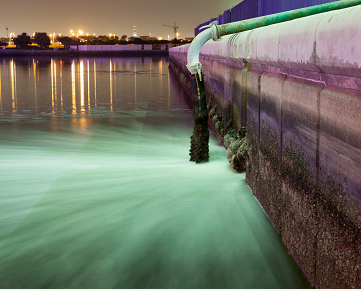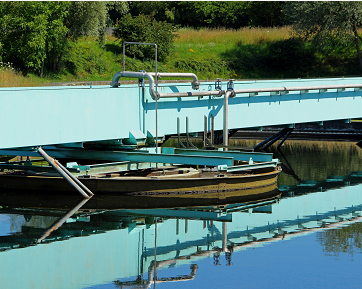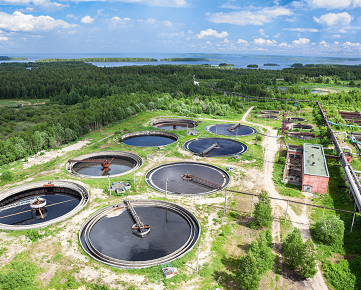1. Excessive aeration is not suitable for sludge culture. The amount of microorganisms is related to the hydrocarbon content in the source water. It is difficult to improve the number of microorganisms due to insufficient hydrocarbon. Simultaneously, enhancing the number of microorganisms will make the sludge aging, which is not suitable for the effluent quality. According to the size of the F/M value, we can know whether the microbial quantity is too low or not, and the deal is not too big as 0.25, which means the microbial amount is not too soft.
To sum up: general activated sludge process can be roughly judged in this way, but it is not suitable for high load activated sludge process because the pollutants of such approach are mainly adsorbed by sludge and removed with the remaining sludge discharge, i.e., M also contains a large amount of F, so in this case, F/M ratio and mud age are not much meaningful for operation control.
2. The microbial activity is not much of a problem if the effluent water temperature is not lower than 10 degrees. The exact calculation formula of sludge age: (adequate volume of aeration tank * sludge concentration) / (discharge volume * reflux sludge concentration * 24), sludge age is the residence time of sludge in the aeration tank, which is an important parameter to control whether the sludge is aging or not, and it isn't easy to ensure the regular operation of the biological system if this parameter is not well maintained. Generally, over 30 days, the sludge is likely to age. The low sludge age, and thus the enhanced biological activity, is not conducive to the mud-water separation in the secondary sedimentation tank.
Summary: The settling rate of high load sludge with short sludge age is generally faster, where the settling performance of high load sludge is better than aging sludge, and the settling rate of sludge with low sludge age is between the above two.
3, SV30 is more than 50%. It may be the problem of filamentous bacteria expansion, less than 25%, the supernatant is turbid, there are fine particles, and many inactive class flagellates (such as side hopper, trichomonas). It may be the reason for the low sludge age.
Summary: SV30 does not exclude the factor of sludge concentration. Whether sludge expansion can be used as a reference for SVI value, sludge expansion is not necessarily caused by too many filamentous bacteria.

4. If the biological system runs at a low load (F/M less than 0.15), dissolved oxygen control at 1.5ppm is sufficient, saving electricity.
Summary: In addition to the biochemical requirements, the dissolved oxygen control should also consider the denitrification of sludge in the sedimentation tank due to lack of oxygen and maintain the activity of reflux sludge as much as possible; the dissolved oxygen of the biofilm process should be higher.
5, control of low dissolved oxygen effluent can make microorganisms in the settlement stage very conducive to microorganisms re-enter the first end of the birth pool after better adsorption and oxidation.
Summary: Aeration tank dissolved oxygen is appropriately high to prevent sludge denitrification in the sedimentation tank, also conducive to activated sludge re-entering the first end of the biological tank after better adsorption and oxidation, so the dissolved oxygen at the outlet of the aeration tank can not be too low.
6. The hydrolysis and acidification section can convert large molecules into small molecules, which is beneficial to the degradation of organic matter in the latter area. In other words, the pollutants in the hydrolysis section are not easily degraded by microorganisms.
Summary: Instead of saying that microorganisms do not readily degrade the hydrolysis section's pollutants, it is better to say that it is an incomplete biochemical reaction.
7, SS becomes larger for many reasons. If the short time change may be related to excessive load, and the long-term, periodic change may be related to filamentous bacteria expansion and sludge aging. Higher influent concentration will lead to enhanced activated sludge activity, which is not conducive to settling. The effluent is turbid and with running sludge: too low load operation, sludge aging, oxidation of microorganisms themselves, and deflocculation. The same will produce a high SS of running mud. Besides, the temperature is too low; aeration is too high, PH changes are too large, toxic substances into the biological system, etc., will also produce running mud.

To sum up: a higher concentration of incoming water will enhance sludge activity but will not be detrimental to settlement; excessive aging and poisoning of sludge will cause mud running, but it is distinguishable in appearance.
8, treatment of domestic sewage N, P generally should not be lack of only right, the remedy of low concentration of sewage, easy to lead to sludge aging, the effluent clip a lot of fine activated sludge particles, this part will lead to the COD of the effluent rise, less activated severe sludge with the water flow out so that the COD rise between 10-20ppm.
Summary: Some statistics show: every 1mg/L ESS exhibits BOD between 0.54~0.69mg/L, with an average of 0.61mg/LBOD.
9. SV is not a critical control parameter indicator in biofilm treatment.
Conclusion: Usually, there is no suspended sludge in the biofilm method, so what to say about SV.
Ten 、The sludge concentration in each tank of the oxidation ditch is not the same, and it is not comparable.
Summary: This is for the alternating oxidation ditch; not only the sludge concentration of each tank is different, but also the sludge concentration of each period of the same tank is not the same.
11. Printing and dyeing wastewater should be more difficult wastewater to treat, and its pollutant decomposition requires a long biological oxidation and contact time. Coloring molecules are complicated for activated sludge, and most of the general microorganisms are excluded from the mud for the removal of coloring substances. Decolorization should be done before the biochemical treatment section. The remaining parts that are not easily removed are removed by biosorption.
Summary: Yes, but biochemical has some effect on the coloration of some dyeing wastewater as well.
12. Contact oxidation is a little better than traditional activated sludge because contact oxidation, with long biological residence time, is easy to degrade complex organics, while biofilm local anaerobic is also suitable for removing degraded organics.
To sum up: the biofilm thickness to make the contact oxidation process high efficiency, the biofilm thickness must be controlled (in fact, it is difficult to control), such as biofilm is too thick or even nodules, its treatment effect will be inferior.
13, reflux ratio is the ratio of reflux sludge volume and biochemical system water intake; controlling the reflux ratio can improve the microbial activity and enhance treatment efficiency.
In summary, a large return ratio does not necessarily mean that more sludge will be returned to the aeration tank because the return flow is too large and its concentration will drop dramatically (subject to the operating condition of the secondary sedimentation tank), which means that there is no concentration concept for the return sludge volume.

14、Process of treatment of substances containing nitrobenzene and aniline: conditioning tank - air floatation - acid tank - iron-carbon tank - alkali tank - sedimentation - hydrolysis acidification tank - secondary sedimentation tank - effluent. Nitrobenzene and aniline are pollutants that are difficult to degrade. For the removal of such wastewater, you must adequately control all processes. Otherwise, the effluent will be very will be stressed.
Summary: This is the general process combination. After the hydrolysis acidification tank also need to set the aerobic process.
15, PAC + cationic PAM is a better flocculant combination. The secondary sedimentation tank is usually not added flocculant. The dewatering room is usually just using cationic PAM.
Summary: Some sludge dewatering before the dosing and conditioning also need PAC and PAM to combine.